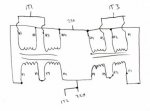Hello all,
I have an odd looking transformer arrangement on a piece of equipment we are refurbishing for our own use. I believe it to be a buck/boost type arrangement, but am confused as to why this particular setup was selected. The unit was removed from working service, so I guess the setup works properly
The unit was supplied with 3 phase 480V power. I am assuming that it was 3 phase delta based on the fact that there was no neutral wire in the original power connection (they just chopped the conduit going to the machine). One component in the unit is a small refrigeration compressor that needs 220V single phase power to run. They are supplying the power to this compressor through two independent single phase transformers. I do not have any information on the transformers themselves (nameplates are gone), but they appear to be just your standard 480/240 to 240/120 isolation transformers with connections labeled H1 through H4 and X1 through X4.
Attached is a diagram that I drew to show how the transformers are currently connected. The points labeled 1T1, 1T2, and 1T3 are where the 480V 3 phase originally connected to the setup. The points labeled 220 are where the compressor was connected. There was no ground connection apparent for this setup. I am assuming they may have had corner-grounded delta power, which is, incidentally, what we have here. Please note that I did not attempt to accurately represent the coil phasing inside the transformers with this drawing! Hopefully the diagram is readable; it looks like the forum software is shrinking it slightly.

My biggest questions at this point are why did they choose this arrangement and are there any recommendations as to connecting this arrangement to a corner grounded delta. I am guessing they may have chosen this arrangement to balance the load to all phases instead of just putting the compressor load on one of the phases. I suppose it is also a possibility that they were using this arrangement to arrive at a smaller transformer than what would have been needed for a standard isolation transformer arrangement. As to the connection to the corner-grounded delta we have in house, my current plan is to connect the grounded phase to 1T2. This should allow for the 220V system to also have a ground reference on one of the wires instead of both wires floating.
If anyone has questions, I will try to answer with the information I have available to me.
Thanks for looking,
Brian
I have an odd looking transformer arrangement on a piece of equipment we are refurbishing for our own use. I believe it to be a buck/boost type arrangement, but am confused as to why this particular setup was selected. The unit was removed from working service, so I guess the setup works properly
The unit was supplied with 3 phase 480V power. I am assuming that it was 3 phase delta based on the fact that there was no neutral wire in the original power connection (they just chopped the conduit going to the machine). One component in the unit is a small refrigeration compressor that needs 220V single phase power to run. They are supplying the power to this compressor through two independent single phase transformers. I do not have any information on the transformers themselves (nameplates are gone), but they appear to be just your standard 480/240 to 240/120 isolation transformers with connections labeled H1 through H4 and X1 through X4.
Attached is a diagram that I drew to show how the transformers are currently connected. The points labeled 1T1, 1T2, and 1T3 are where the 480V 3 phase originally connected to the setup. The points labeled 220 are where the compressor was connected. There was no ground connection apparent for this setup. I am assuming they may have had corner-grounded delta power, which is, incidentally, what we have here. Please note that I did not attempt to accurately represent the coil phasing inside the transformers with this drawing! Hopefully the diagram is readable; it looks like the forum software is shrinking it slightly.

My biggest questions at this point are why did they choose this arrangement and are there any recommendations as to connecting this arrangement to a corner grounded delta. I am guessing they may have chosen this arrangement to balance the load to all phases instead of just putting the compressor load on one of the phases. I suppose it is also a possibility that they were using this arrangement to arrive at a smaller transformer than what would have been needed for a standard isolation transformer arrangement. As to the connection to the corner-grounded delta we have in house, my current plan is to connect the grounded phase to 1T2. This should allow for the 220V system to also have a ground reference on one of the wires instead of both wires floating.
If anyone has questions, I will try to answer with the information I have available to me.
Thanks for looking,
Brian
